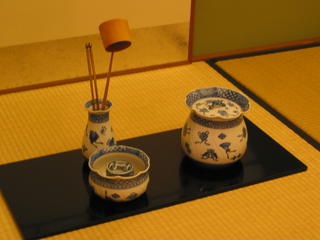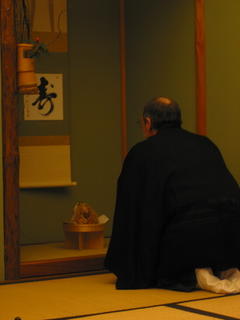
Part of getting involved with any culture is appreciating and acquiring stuff, stuff that is particular to that culture. I am Italian-American and when I think about it I have five espresso machines, grow garlic, oregano and basil in the garden, order olive oil and vinegar from Alberto who lives in a small town outside of Florence and should be collecting all my mother’s mothers’ aphorisms. She tells me these approximately three times per week, the most recent in honor of my 50th birthday. It is concerned with the fact that after fifty you wake up with a new ache and pain every morning. The unfortunate part of most these pearls of wisdom are that they are usually true. Thanks Ma.
Once I became interested in oriental culture, it took quite awhile to differentiate between the different Asian cultures. I find that most objects I come in contact with are Chinese and seldom Japanese that is if you exclude Sony’s. The Japanese stuff I do manage to find is usually very well made and expensive. There are a few stores in Chicago that I have bought many a Christmas present in, but mostly Japanese stuff is hard to find.
When I started taking lessons in the Tea Ceremony I was overwhelmed by the amount of stuff there was. These objects are the stuff of legend: scrolls, flower vases, ceramic and cast iron vessels, whole rooms, and that pen ultimate Japanese treasure, the tea bowl.
There is a dilemma in the practice of Tea in the west if one is trying to use the traditional utensils or dogu. It is almost impossible to have all the utensils and would be very expensive to obtain them. The utensils you get here might not even be appropriate in Japan, but because they are the only things you can find, they get used.
My wife Charlotte and I wander around the country and whenever we are out-and-about, Charlotte will take me into whatever antique or junk store she can find. We snoop around and look for things. She looks for some priceless antique to take to the Antique Roadshow, while I am looking for tools but also I keep an eye out for objects that I might somehow use in the practice of Tea.
I have always thought that we, practicing Tea in the West, need to create our own Tea culture and provide our own utensils. With that thought in mind I am always looking for something that might substitute for Japanese dogu. In my quest for western dogu I have done everything from making tea stands out of recycled barn wood from Southern Illinois to purchasing American crafts and antiques, which I perceived, would substitute for the Japanese utensils. This usually turns out to be a mistake. I have collected some very interesting objects but most have not been usable for Tea.
There are a couple of concepts that are prominent in Tea and in Japanese fine arts—Wabi and Sabi. I have translated these to mean rustic elegance. It is the difference between a beautifully crafted Wedgwood teapot and a raku tea bowl that at first looks to the untrained eye like it was thrown together haphazardly. The difference lies in their use and in the aesthetics. I have tired to use Western objects in Tea but they usually do not work. And by work I mean they are too tall, too short, too wide; there is no place to comfortable to hold on to them, they get to hot, there is no place for the lid or there is no lid.
At first glance some of the structure of a Tea room and the utensils look down right a-symmetrical and random, sort of like a raku Tea bowl, but once put together and used as a cohesive unit, they function perfectly. I do not know why this surprises me because all of this stuff has a 400 plus year history of development and design that follows the Zen principles of fukinsei and kanso (asymmetry and simplicity), plus a history of crafts persons working in tandem with the practitioners of Tea to make objects that are elegant in form and function.
In a world of general consumer goods, I have always thought that Sony from Japan and HP from the US have this aesthetic down. Besides the way they work, they are usually beautiful objects. Ergonomically made to function intuitively, being made out mostly of plastic, they are made with attention to texture, color and feel such as Sony portable CD players and the HP 11c calculator.
Then we come to the packaging of Japanese stuff. It is very exciting to receive a gift from Japan. I know that opening it is going to be a compelling experience regardless of what it contains. Layer upon layer of complicated textures and designs on beautiful paper. Even in a box of cookies there are multiple sleeves of paper with much writing. I only wish I could understand them. But as with many things understanding might take some of the mystery away. I am assuming some of these sheets of calligraphy are ingredient lists: flour, sugar, hydrogenated vegetable oil, MSG, etc. It is probably better off not knowing what they say and retain the illusion.
Tea utensils are stored in wooden boxes, wrapped in their own silk napkins and closed with a colorful ribbon. The boxes are made out of a light in color and weight, open grained wood with meticulous joinery and handwritten calligraphy adorning the top stating the provenance of the object.
My experience is that most Japanese stuff is not out in the open but packed lovingly away and living in their handsome wooden boxes out of sight, waiting for the time to come out and see the light of day for some special purpose. In the Tea Ceremony a lot of time and effort is devoted to the different dogu that is chosen for each event. The dogu is picked specifically for each occasion, time of year and guest. They may be family heirlooms or valuable antiques and you may never see them again. This unlike most Western homes where our nick-knacks are always on display.
A protocol exists for when to use, how to handle, describe and appreciate Tea dogu. With most of these objects it requires some knowledge to appreciate them. Important facts such as which generation of the crafts person produced it, from what region does it come from and did someone special, such as a Grand Tea Master, give the object a name. This information always offered during Tea.
One of the more interesting tea proceedings is called Chabako. It consists of a series of tea ceremonies from the very simple to more complex and presents an opportunity to collect multiple little objects. Chabako refers to a box, which I think was originally developed to transport the necessary utensils for Tea in a small self-contained package. All the stuff is contained in a small box about three quarters of the size of a tall box of Puffs. The box is made out of clear wood held together with complicated Japanese joinery. They can be unfinished or lacquered, always has a lid and many times another small shelf inside.
Inside live the natsume (a small tea caddy), chawan (tea bowl), chakin (small linen cloth) and its porcelain holder, chasen (bamboo wisk) and its wooden container, chashaku (wooden scoop) in its cloth case, and sweets in a porcelain vessel. The chabako is carried into the tearoom on a round lacquer tray to where a cast iron teakettle rests. So you get my point. You can go on and on searching for and acquiring stuff, in fact you can make a life’s work out of it.
Chabako was one of the first types of Tea ceremonies I was exposed to and having some wood working skills I made two boxes to fit my collection of tea gear it. One being as bit to big and crudely made, the other constructed much better (experience pays off) but probably a bit too small. That brings me back to one of my first points, that even if many tea utensils look somewhat rough hewned, they are designed to very exact tolerances. When I made the boxes myself and was able to measure “real” ones, I still was not quite able to get them exactly right.
The acquisition of Japanese stuff has filled every corner of my home, much to wife’s dismay. Being that we do not own any curio cabinets, my stuff is distributed throughout the house on every available shelf. The boxes, the dogu should be living in, fill all the closets and all the stuff, instead of hiding, is out collecting dust and providing me with a wonderful visual palette, along with our painted saws from Southern Illinois.




